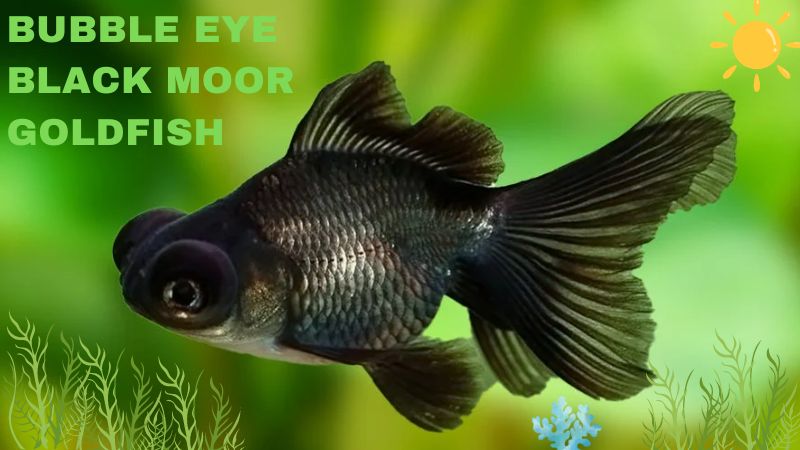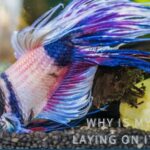The captivating world of goldfish boasts a diverse array of breeds, each with unique characteristics. Among these, the Bubble Eye Black Moor stands out with its mesmerizing appearance. This fancy goldfish is a captivating combination of the classic Black Moor’s telescope eyes and fluid sac-like growths beneath them, resembling bubbles. While undeniably beautiful, the Bubble Eye Black Moor Goldfish requires specific care considerations due to its delicate eye features. This article from Tropical Fish Haven will provide you with guidance on caring for this fish.
What is Bubble Eye Black Moor Goldfish?
The Bubble Eye Black Moor Goldfish lineage traces back to the Spectacled Moor, a descendant of Japan’s renowned two-tailed Wakin Goldfish breed, scientifically named Carassius auratus auratus var.
Selective breeding has yielded popular goldfish varieties such as Ranchus, Orandas, and Fantails, rarely encountered in the wild except when released by aquarium keepers.
Additionally, the Black Moor Goldfish with Bubble Eyes features large fluid-filled sacs beneath each eye. These protrusions, situated beneath delicate skin flaps, can hinder the fish’s swimming and foraging abilities. They move and flex with the fish’s motions, characteristic of this particular goldfish type.
Bubble Eye Black Moor Goldfish Care Guide
Tank Size
For optimal comfort, a minimum tank size of 10 gallons is necessary, though starting with a 20-gallon tank is recommended if possible. Despite not being strong swimmers, these goldfish benefit greatly from ample space.
Aquarium Setup
If the tank is primarily for display, choose a taller rather than wider tank. Taller tanks accommodate taller plants like Vallisneria and provide a larger viewing area.
Water Quality
Maintaining clean and balanced water is crucial for Bubble Eye Black Moor Goldfish. Regular water changes are essential, with a recommendation of replacing a quarter of the water weekly. This practice helps keep ammonia and nitrate levels low, as these fish are particularly sensitive to water quality issues.
Here are the recommended water parameters to maintain:
- Water temperature: 60–80°F
- pH: 6.0–8.0
- Ammonia: 0 ppm
- Nitrites: 0 ppm
- Nitrates: 20 ppm
- General hardness (dGH): 7–11 (130–200 ppm)
- Carbonate hardness (dKH): 5–8 (89–142 ppm)
Decorations
Decorations in the aquarium should be chosen carefully for Bubble Eye Goldfish, as they are prone to poor eyesight and may inadvertently bump into objects. Sharp edges in the tank can potentially injure their delicate eye sacs, leading to leakage of body fluids and collapse of the telescopic eye structure. Once damaged, these eyes cannot heal or reinflate but instead retract into the eye socket, surrounded by excess skin.
Tank Substrate
Choose plain, medium-sized gravel as the substrate, ensuring it is smooth. Although not traditional bottom feeders, Bubble Eye Goldfish often browse along the tank’s bottom, making smooth gravel essential to prevent injuries to their delicate eye sacs.
Tankmates
Selecting suitable tankmates for Bubble Eye Goldfish can be challenging due to their vulnerable eye sacs. Their slow swimming speed also makes it difficult for them to compete for food with faster fish, potentially leaving them underfed.
Bubble Eye Goldfish thrive best when kept in groups of their own kind. If planning a community tank, opt for fish with similar characteristics to ensure compatibility. Consider these suitable tankmates:
- Lionhead Goldfish
- Telescope Goldfish
- Celestial Goldfish
Diet and Feeding of Bubble Eye Black Goldfish
Feeding Bubble Eye Black Goldfish requires patience due to their visual and swimming impairments, which make eating a slower process compared to other fish. For this reason, it’s advisable to house them with slower-moving, visually distinctive goldfish or similar species with bubble eyes.
When selecting food for Bubble Eye Black Goldfish, opt for varieties with slightly higher protein levels, typically between 33% to 38%. Fancy varieties like these require more energy to swim regularly, so a diet with a bit more calories can help them maintain their activity levels.
It’s important to note that Bubble Eye Black Moor Goldfish cannot be overfed. Goldfish have rudimentary stomachs and eat slowly compared to other fish species. They typically fill their mouths with food, chew carefully, and swallow before eating more.
Breeding Bubble Eye Black Goldfish
Bubble Eye Black Goldfish can reproduce rapidly under optimal conditions. Start with an initial temperature of 60 degrees Fahrenheit, gradually increasing it each day to a range of 68–74 degrees Fahrenheit. As the temperature rises, the male will begin to chase the female.
After spawning, these fish are known to immediately consume their eggs. Therefore, it’s crucial to prepare a separate tank to raise the fry. Eggs typically hatch within 4 to 7 days.
Feed the fry with infusoria and other powdered foods until they are large enough to consume larger particles. Initially, the fry do not exhibit the characteristic eye sacs, which begin to develop around 6 months of age.
Conclusion
Bubble Eye Black Moor goldfish possess several distinctive traits, necessitating careful attention when creating their habitat. If you can meet the conditions outlined above, we encourage adding this fish to enhance the uniqueness of your aquarium. Stay updated with Tropical Fish Haven for more valuable information!





